World’s Most Recognized Bigfoot Cast
Posted by: Loren Coleman on April 5th, 2010
What Bigfoot casts are in your personal 2010 collection?
One of the most popular, collectible Bigfoot casts is the impression of the seemingly most perfectly imprinted Sasquatch track in existence. It is easy to identify it, and it can be seen below, one of the copies of the footprints from the Patterson-Gimlin encounter of October 20, 1967.
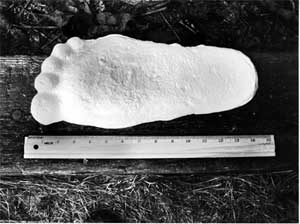
Skeptical writers, such as Michael Dennett, have used it as their example to discuss Bigfoot prints.
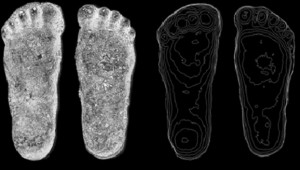
Sasquatch research scholars, including Jeff Meldrum and Grover Krantz, have too.

Websites (e.g see here) selling casts, long ago, have made this one special Bigfoot cast available for purchase, and the most popular one sold.

Bob Titmus and Syl McCoy with Bigfoot casts. Photo by John Green.
Who made the first copy of this cast available for sale is perhaps unknown, although it appears certain that Bob Titmus sold the first copies of Bigfoot casts found around Bluff Creek in 1958 and 1959 (as I document in my Tom Slick books). What is known today is this specific 1967 filmsite track copy is certainly the most recognized Bigfoot cast in the world.
Of course, ten footprints were found in the original trackway left by the October 20, 1967 Bigfoot, and reportedly, all were cast.
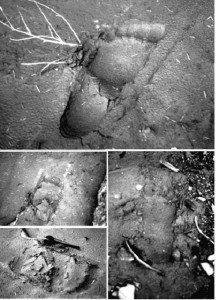
Photos: Lyle Laverty, October 1967, Bluff Creek, California.
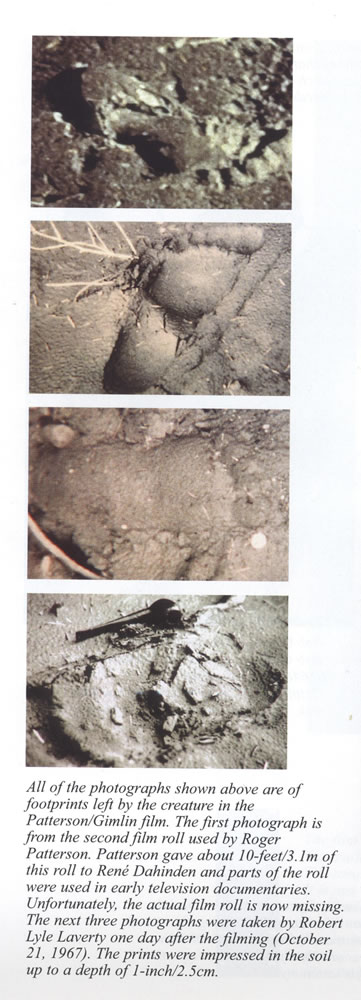
Nevertheless, only in recent years, have some of the other casts been copied and obtained by serious researchers. The most famous “second” cast, nowadays, appears to be what Jeff Meldrum calls the “mid-tarsal break” footprint cast.
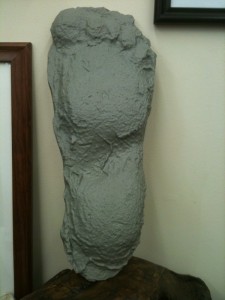
Photos (above, below): International Cryptozoology Museum, 2010. Part of the 150 casts in the collection, archived at the museum, which are routinely placed in the changing exhibits. Donations appreciated from Jeff Meldrum and Bill Dranginis.
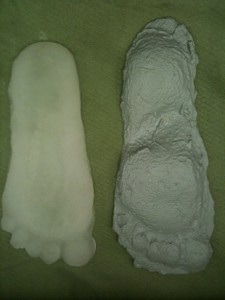
A third print cast from the Patterson-Gimlin filmsite series is also appearing in collections, as seen below the less common left foot “flat filmsite” cast.
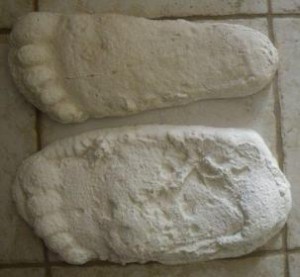
Unfortunately, as has been realized in the past, the easily obtained P-G filmsite cast has turned into a liability sometimes. The cast has been used in hoaxes, as investigator Scott McNabb harshly learned in 1998. McNabb found this out when someone left a fake print for him to find during a Tennessee Bigfoot search trip.

The McNabb cast compared to the readily available P-G filmsite cast that has been sold online for over two decades.
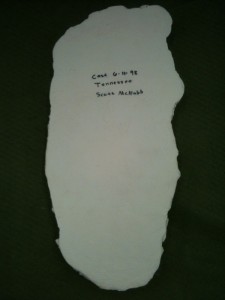
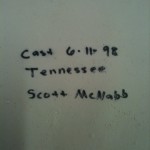
It is recommended that serious Bigfoot researchers become very familiar with all casts (including the frequently sold Grays Harbor series) that are now coming into the retail trade, no matter where one might live or search.
About Loren Coleman
Loren Coleman is one of the world’s leading cryptozoologists, some say “the” leading living cryptozoologist. Certainly, he is acknowledged as the current living American researcher and writer who has most popularized cryptozoology in the late 20th and early 21st centuries.
Starting his fieldwork and investigations in 1960, after traveling and trekking extensively in pursuit of cryptozoological mysteries, Coleman began writing to share his experiences in 1969. An honorary member of Ivan T. Sanderson’s Society for the Investigation of the Unexplained in the 1970s, Coleman has been bestowed with similar honorary memberships of the North Idaho College Cryptozoology Club in 1983, and in subsequent years, that of the British Columbia Scientific Cryptozoology Club, CryptoSafari International, and other international organizations. He was also a Life Member and Benefactor of the International Society of Cryptozoology (now-defunct).
Loren Coleman’s daily blog, as a member of the Cryptomundo Team, served as an ongoing avenue of communication for the ever-growing body of cryptozoo news from 2005 through 2013. He returned as an infrequent contributor beginning Halloween week of 2015.
Coleman is the founder in 2003, and current director of the International Cryptozoology Museum in Portland, Maine.










I have copies of the most famous cast as well as the mid-tarsal break cast, and they are great additions to any crypto-collection. I also have a copy of the October 1963 Al Hodgson cast also believed to be “Patty.”
Right now, just a set of the Bossburg Tracks.
I have some N’th generation Patterson Bluff Creek cast, or so I was told, in a box in my attic. It cost me twenty bucks back in the early 90’s and I got it from someone on the ol’ IVBC. I never claim it to be “authentic” but it’s fun to have. Some day I’ll make a shadow box for it.
Greetings All!
I have a copy of the “full left” print from Paul Freeman’s June 1982 Umatilla National Forest casts. It came with a pamphlet/book by Grover Krantz about the prints and the whole episode.
What caused the mid-tarsal break in that footprint? a buried tree root?
I’m sorry to say but most bigfoot/sasquatch tracks are just grizzly bear prints mistaken as a sasquatch prints. Before you tear my head off check this picture of an average grizzly print (12 inches or 30cm). Now picture a giant grizzly’s print would measure right around 15 inches or bigger. This mistake is caused by the way a bear walks when it steps with it’s back paw it steps on the print made by his front paw which has a different distinctive look. So when it walks like this the back sasquatch looking print covers the obvious front paw print and if the bears claws are worn down from rocks or whatever you get a mistaken sasquatch print. Also note the arch in the middle of most prints match the one the grizzly bear and also the nice little round human looking toes are also a match.
I thought I was coming into this discussion way late…then I see that the post preceding mine was only about two weeks ago.
Sorry, manitobasabe. That don’t cut it. Jeff Meldrum and John Bindernagel are extremely familiar with both primate and bear tracks. They’ve ruled out bears as the cause of a significant number of trackways. You need to read up on this topic.
I’m going with the experts every time. Not only that; not even I would confuse a sasquatch with a bear track.
DWA I want to believe it as much as you do but the more research I do I am realizing there is not much to go on in fact there is nothing. No hairs, no conclusive dna, no bodies, no “real” good footage, no bones, no droppings, nothing what so ever. bottom line is that any one of the above footprints may have been done by a grizzly bear. your so called professionals simply ruled out a grizzly bear because there is no claw marks. grizzly bears that live in the rockies climb rocks all the time and this causes the back claws to wear down and sometimes wear completely off. now when a bush man finds a print like this of a big old bear with worn off claws his imagination runs wild with possible explanations and thats how the legend of sasquatch was born. About the primate thing primates have knuckles on their toes. grizzlies don’t none of the casts have knuckles. the mid tarsel break is the exact same on the “sasquatch” prints as the grizzly. Ever notice prints are only usually found where there is populations of grizzlies? here are more pics of grizzly prints. notice one of the ones in the sand has no claws on the back paw print? the last one is a primates foot. Sorry DWA I just completely debunked the whole sasquatch print thing. And there is no professionals on Sasquatch because no one has anything to study but so called B.S. stories. Everyone has a story but not of them has proof.
“DWA I want to believe it as much as you do but the more research I do I am realizing there is not much to go on in fact there is nothing.”
There is no “wanting to believe” in science. There is analysis of the evidence and there are conclusions drawn from that analysis. That’s the only way I care about this. The evidence is of a volume and consistency that has convinced every scientist who has paid proper attention to it that, at the very least, we have a legitimate scientific quest on our hands. Show me a scientist who disagrees and I will show you, in his first two sentences, at least four earmarks of “I am unacquainted with the evidence.”
Period.
You are confusing evidence and proof. That’s a common “skeptical” misstep. There is so much to go on that a concerted scientific effort – which has never come close to beginning to be conceived – would do one of the following two things, within weeks: confirm the animal, or convince everyone involved in that effort that it will lead to confirmation. Period. That’s the way to bet, at least, every penny you have, if you are a betting man. The evidence ALWAYS shows the way to bet. And to bet against the evidence simply isn’t smart. Period.
When an expert in a directly relevant field says these are primate tracks, well, they are, until they are shown not to be.
You are NOT telling me that the prints at the top of this blog come from bears. You are NOT.
I think that what happens to a lot of people who “want to believe” is that they get frustrated and turn cynical. Blind belief will do that. It’s easy to get frustrated when one isn’t paying attention to how science works…and to how, in this case, with a few exceptions, science just isn’t working.
Me, I just know what the evidence says.
And the evidence says, about as clearly as evidence can:
This ain’t bears.
Period.
(If climbing rocks caused its claws to wear off, the grizzly would be extinct. Period.)